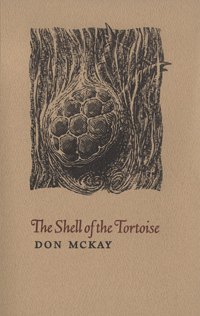Reviews
Nonfiction Review by Theresa Kishkan
Don McKay, The Shell of the Tortoise (Kentville: Gaspereau, 2011). Paperbound, 149pp., $25.95.
Don McKay and Gaspereau Press have done it again. They’ve collaborated— Don’s writing, Gaspereau’s design aesthetic and production values—to create an object as beautiful to hold in the hand as it is to weigh and ponder in the mind. Four essays and an assemblage, though in truth these essays are to some degree assemblages too. McKay is a writer who isn’t shy of including poetry, asides, jokes, and geological detours to embellish the map, fill the jar, add harmony to the melody of the lyre’s first music.
The first essay in this collection, “Ediacaran and Anthropocene: Poetry as a Reader of Deep Time,” takes us into McKay territory, the terrain of geopoetry, “the place where materialism and mysticism, those ancient enemies, finally come together, have a conversation in which each harkens to the other, then go out for a drink.” This is a deceptively casual invitation to the reader to pay attention to recent thinking about time, both as meditation on geological periods and their nomenclature, and the relationship of our species within that meditation. McKay, at once playful and deeply (even gravely) serious, guides our hands across the fossils on the “flat tilted beds of sedimentary rock” at Mistaken Point on the Avalon Peninsula in Newfoundland, and encourages us to experience astonishment.
“From Here to Infinity (or so)” is also a riff on time and place, or time through place, specifically the Loss Creek-Leech River Fault on Vancouver Island. In 1996, McKay, new to British Columbia, took on the Fault, on foot, as a research project. Determined to learn about geology, he describes his apprenticeship to this specific place, the native flora and fauna, human history (there was a brief gold rush on the Leech River, beginning in 1864; as a young woman, nearly forty years ago, I remember exploring the remains of Leechtown, reduced to some foundations and a few iron pots), the history of logging, as well as contemporary clear-cut practices. The lessons are temporal and abstract: river courses, igneous basalt, and schists; plate tectonics; and the memory maps of black bears. Accompanying these field notes is a discussion of the wider parameters of deep time, vis-à-vis James Hutton, accompanied by several of McKay’s poems, which enter the discourse through metaphor, “the sweet / perils rushing in the creek crawling / through the rock.” And of course, as the title of the essay promises, there is a nod to From Here to Eternity, the novel by James Jones, made into a Hollywood film in 1953. “Eternity,” says McKay, “is thinkable infinity, and that thinkability is largely due to its embrace of a narrative shape.”
The title essay skilfully examines the origins of the lyre, of song, and how inventiveness and risk reside at the heart of creation. “Invoking Hermes the lyre-maker is a way to remind ourselves that art grows in uncertainty, in trouble, in the coming-together of unlikely combinations.” McKay celebrates bricolage, the inspired work that comes of using what’s at hand, materials themselves alive and electric— “that quiver of imminent metamorphosis, in the vibrant aesthetic pause they create, in the arresting moment of art.” It was Hermes, after all, who made his lyre from a tortoise shell, using reed for the neck and crosspiece, stringing it with sheep gut, and covering it with hide. And what is particularly intriguing about this piece is McKay’s sidling into the river of language, “imagining inside that current the potent counter-rhythm created by the upstream surge of the chum and coho salmon intent on reaching their spawning redds.” The language is resonant with water, airy rushes, the spin of a flyfisher’s reel, the soft plash as the line falls upon the surface of the river, insects humming in the air. There is room in this thinking for chance, for the sidelong arrival of poetry in the dark waters of Campbell River, where McKay wrote this essay while resident in the Haig-Brown House.
Both “The Muskwa Assemblage” and “Great Flint Singing: Reflections on Canadian Nature Poetries” are pieces I’ve seen before, in other contexts. The former was a beautiful hand-sized letterpress book by Gaspereau in 2008 (and before that, a privately printed chapbook), every element integral to both the design and the form of the assemblage itself— cover of blue, handmade paper, rough and pebbled, embossed with handsome Jenson caps in slate grey, and the text so carefully arranged to take the reader through the Muskwa-Kechika wilderness. “Write down this caribou, a young buck crossing the Gataga on soft snowshoe hooves, write shaggy elegance, write those improbable parentheses it carries on its head like a waiter carrying a tray of silence into the other world.” Although this presentation is handsome, I wonder if it was necessary to give us the piece again, so soon. ”Great Flint Singing” was invaluable as an introduction to the 2009 anthology, Open Wide a Wilderness: Canadian Nature Poems, edited by Nancy Holmes, because a reader could use it as a thematic guide through specific poems in the collection. In this book, it is a little like a tool without its materials. But that’s a minor quibble. The ultimate pleasure of The Shell of the Tortoise is the opportunity to spend time, deep or ephemeral, with a fine mind at work and play in the language, choosing his materials for their beauty and their durability.
—Theresa Kishkan









